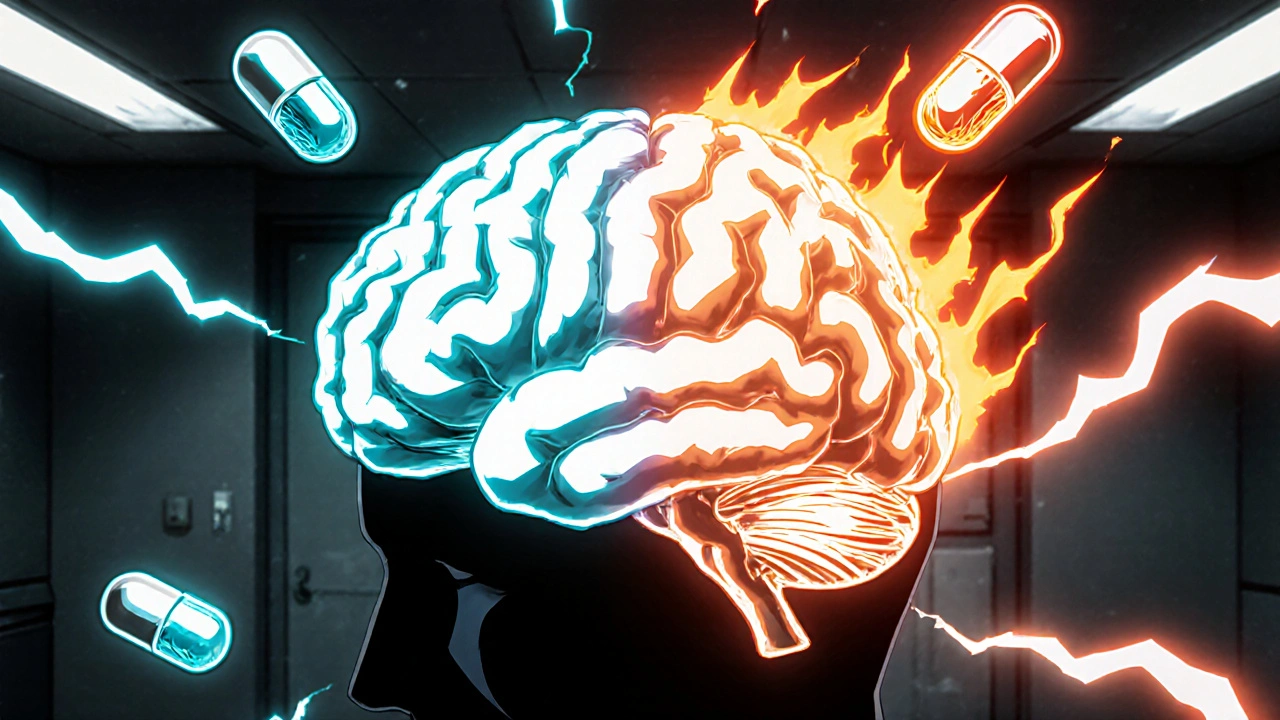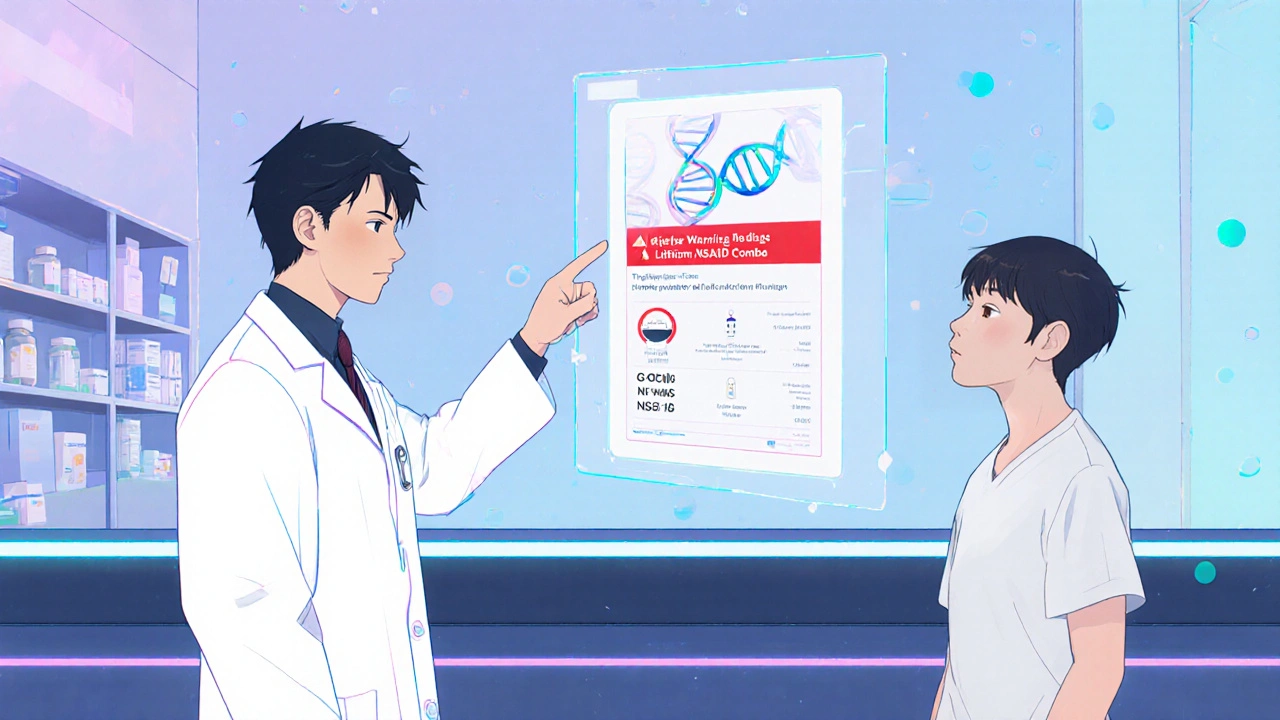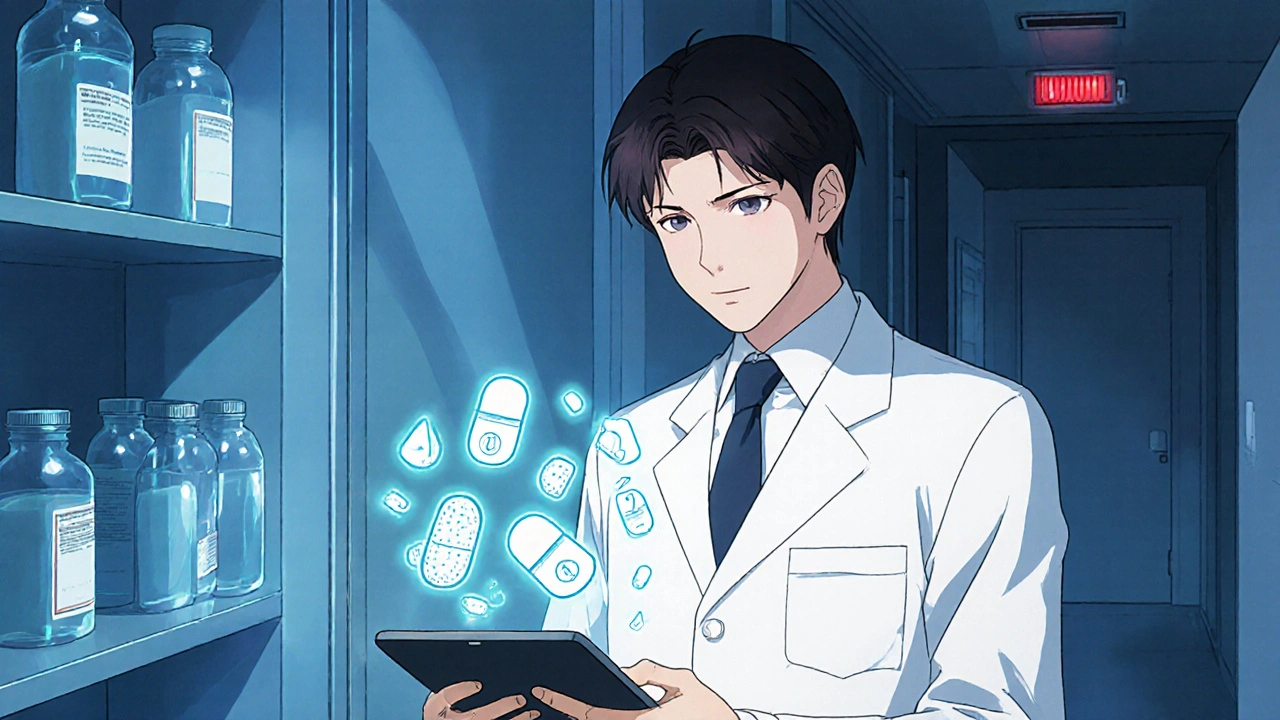Psychiatric Medication Interaction Checker
When two or more psychiatric drugs are taken together, the result isn’t always just additive relief - sometimes the mix can trigger life‑threatening reactions. Understanding psychiatric medication interactions - the ways drugs alter each other’s effects - is the first step to keeping patients safe.
Key Takeaways
- Serotonin‑boosting drugs combined with MAO inhibitors or certain opioids can cause serotonin syndrome, a potentially fatal condition.
- Lithium levels jump 25‑50% when taken with NSAIDs, diuretics, or ACE inhibitors, raising toxicity risk.
- Cytochrome P450 (CYP) inhibition is the dominant mechanism behind many dangerous combos; fluvoxamine is the strongest CYP inhibitor among SSRIs.
- First‑dose monitoring for 2‑4 hours and structured follow‑up for the first 7‑10 days dramatically cuts severe adverse events.
- Pharmacogenomic testing and digital interaction alerts are emerging tools that can further reduce risk.
Why Interactions Matter: Core Mechanisms
Three neurotransmitter systems dominate psychiatric pharmacology: serotonin (5‑HT), norepinephrine (NE) and dopamine (DA). Drugs that shift any of these pathways can unintentionally amplify each other’s effects. The most common mechanisms are:
- Cytochrome P450 enzyme inhibition - many antidepressants block CYP1A2, CYP2C9, CYP2C19 or CYP3A4, causing co‑administered drugs to accumulate.
- additive GABAergic or anticholinergic load - seen when tricyclic antidepressants (TCAs) meet antihistamines or antipsychotics.
- Altered renal handling - lithium’s narrow therapeutic range makes it vulnerable to changes in sodium balance.
When a new pair is started, the body has no time to adapt, which is why the first‑dose window is the most dangerous.
High‑Risk Classes at a Glance
| Class | Typical Interaction Mechanism | Notable Dangerous Combos | Monitoring Focus |
|---|---|---|---|
| SSRIs | CYP450 inhibition (especially CYP2C19, CYP3A4) | SSRI + MAOI, SSRI + tramadol, SSRI + warfarin | Serotonin syndrome signs, INR, drug levels if applicable |
| MAO inhibitors | Irreversible MAO blockade → massive serotonin rise | MAOI + any serotonergic agent (SSRIs, SNRIs, triptans) | Serotonin syndrome, blood pressure spikes |
| TCAs | Anticholinergic + CYP2D6 metabolism | TCA + alcohol, TCA + antihistamines, TCA + CYP inhibitors | QT interval, sedation level, blood pressure |
| Lithium | Renal clearance, sodium balance | Lithium + NSAIDs, lithium + thiazide diuretics, lithium + ACE inhibitors | Serum lithium (0.6‑1.0 mmol/L), renal function, electrolytes |
| Atypical antipsychotics | Variable CYP metabolism, additive sedation | Quetiapine + benzodiazepines, olanzapine + CYP3A4 inhibitors | Metabolic panel, AIMS for movement disorders, sedation scores |

Spotlight on the Most Dangerous Combinations
Below are the combos that clinicians flag as red‑alert in electronic prescribing systems.
- SSRIs + MAO inhibitors - The classic serotonin‑syndrome trigger. Even a low‑dose SSRI started within two weeks of an MAOI washout can raise 5‑HT levels to toxic levels. Symptoms: agitation, hyperreflexia, hyperthermia, tremor. Mortality: 2‑12% in severe cases.
- SSRIs + Tramadol - Tramadol is both a weak serotonin reuptake inhibitor and a CYP2D6 substrate. Combining it with an SSRI that blocks CYP2D6 (e.g., fluvoxamine) can cause serotonin syndrome and raise tramadol levels, increasing seizure risk.
- Lithium + NSAIDs (ibuprofen, naproxen) - NSAIDs reduce renal prostaglandins, decreasing lithium clearance. Serum lithium can jump 25‑50% within days, pushing patients into toxicity (tremor, ataxia, confusion).
- MAO inhibitors + Tyramine‑rich foods - Not a drug‑drug interaction, but a diet‑drug one. Sudden hypertensive crises (headache, palpitations) can be fatal if not recognized quickly.
- TCAs + Alcohol - Both depress the central nervous system via GABA potentiation. The combo doubles sedation and can cause dangerous respiratory depression, especially in older adults.
- Antipsychotic + CYP3A4 inhibitor (ketoconazole, fluvoxamine) - Increases antipsychotic plasma concentrations, raising the risk of QT prolongation and metabolic side effects.
Monitoring Protocols that Save Lives
Guidelines from the American Association of Psychiatric Pharmacists (AAPP) and the Black Book of Psychotropic Dosing and Monitoring recommend a three‑step safety net:
- Baseline assessment - Record vital signs, ECG (for QT‑risk drugs), serum levels (lithium, carbamazepine), and relevant labs (CBC, LFTs, renal function).
- First‑dose observation - Keep the patient under observation for at least 2-4 hours after the initial dose of the new drug, watching for dizziness, nausea, tremor, or changes in mental status.
- Structured follow‑up - Schedule visits or tele‑checks at day 3, day 7, and day 14. Labs should be drawn weekly for lithium, INR weekly for SSRI + warfarin, and liver tests every 3 months for valproate or clozapine.
Specific checklists per class:
- SSRIs + MAOI: Monitor for rigidity, hyperthermia, diaphoresis; hold both drugs for at least 14 days after MAOI discontinuation.
- Lithium + NSAID: Re‑check serum lithium within 3‑5 days; reduce lithium dose by 20‑30% if level rises.
- Antipsychotic + CYP inhibitor: Obtain ECG before starting, repeat after 1 week, and adjust dose if QTc > 450 ms.
Practical Checklist for Clinicians
- Identify every psychiatric drug the patient is taking - include over‑the‑counter sleep aids and herbal supplements.
- Consult a reliable interaction database (e.g., Micromedex, Lexicomp) before adding a new agent.
- Ask about recent changes in diet (especially tyramine) and alcohol consumption.
- Check for CYP450 inhibitors or inducers in the patient’s medication list.
- Document baseline labs, ECG, and symptom scores (PHQ‑9, GAD‑7, AIMS).
- Schedule first‑dose monitoring and set clear follow‑up intervals.
- Educate the patient on red‑flag symptoms: severe headache, fever, rapid heartbeat, extreme confusion, tremor, or sudden swelling.

Emerging Tools: Pharmacogenomics & Digital Alerts
Pharmacogenomic testing for CYP2D6 and CYP2C19 variants is becoming routine in many psychiatric clinics. The Clinical Pharmacogenetics Implementation Consortium (CPIC) 2022 guidelines show that poor metabolizers of CYP2C19 should avoid escitalopram or receive dose reductions, cutting interaction risk by up to 30%.
Digital therapeutic platforms now integrate real‑time interaction checking. One recent study (U.S. Pharmacist, 2023) reported a 37% drop in serious adverse events after implementing automated alerts that flag dangerous drug combinations at the point of prescribing. These systems also generate personalized monitoring schedules, reducing the workload on busy clinicians.
Looking ahead, the National Institute of Mental Health is piloting AI‑driven models that combine medication history, genetic data, and comorbid conditions to predict patient‑specific interaction risk. Early results suggest a 45% increase in early detection of high‑risk combos compared with standard databases.
Frequently Asked Questions
What is serotonin syndrome and how quickly does it appear?
Serotonin syndrome is an acute condition caused by excess serotonergic activity. Symptoms usually emerge within 30 minutes to 24 hours after the triggering combination, starting with agitation and sweating, then progressing to hyperreflexia, fever, and in severe cases, seizures or death.
Can I take an over‑the‑counter cold medicine with my SSRI?
Many decongestants (pseudoephedrine) are safe, but antihistamines that have strong anticholinergic properties, such as diphenhydramine, can add sedation and increase anticholinergic load. Always check the specific ingredient and discuss with your prescriber.
How often should lithium levels be checked when I start an NSAID?
Re‑check serum lithium 3‑5 days after the NSAID is introduced, then weekly until the level stabilizes. If the concentration rises above 1.0 mmol/L, consider a 20‑30% dose reduction.
Is it safe to combine an atypical antipsychotic with a benzodiazepine?
Short‑term use for acute agitation is acceptable, but long‑term combination can increase sedation, respiratory depression, and metabolic side effects. Monitor sedation scores and consider tapering the benzodiazepine after stabilization.
Do pharmacogenomic tests guarantee no interactions?
Testing reveals genetic enzyme activity, which helps predict drug levels, but it doesn’t account for diet, other medications, or organ dysfunction. Use the results as a guide, not a guarantee.
Bottom Line
Psychiatric medication interactions aren’t just academic-they’re a daily reality that can turn a helpful prescription into a medical emergency. By knowing which classes carry the highest risk, applying structured monitoring, and leveraging modern tools like pharmacogenomics and digital alerts, clinicians can dramatically lower the odds of dangerous drug combinations.


Paul Luxford
October 26 2025I've seen a lot of clinicians underestimate how quickly serotonin syndrome can develop when a new SSRI is added on top of a MAOI. The first‑dose window is really the most vulnerable period, especially if the washout wasn't complete. Keeping a close eye on temperature, tremor, and mental status for a few hours can catch problems early. Also, checking basic labs before you start a lithium‑NSAID combo saves you from surprise toxicity. In short, a structured monitoring plan is the cheapest way to avoid a catastrophe.